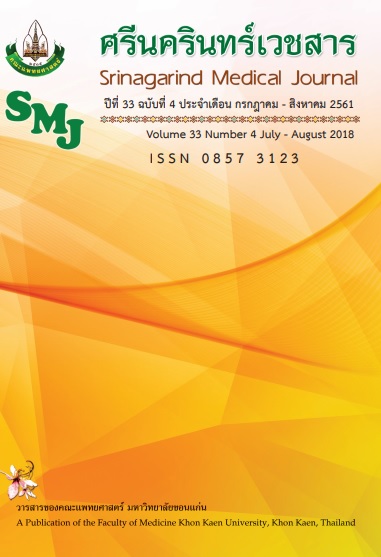The Association between Circle of Willis Patterns and Ruptured Aneurysm Sites
Keywords:
N/A, Subarachnoid hemorrhage; cerebral aneurysm; circle of Willis; atypical pattern; anterior communicating arteryAbstract
Background and Objectives: Intracranial aneurysmal rupture is the major cause of subarachnoid hemorrhage (SAH). Misdiagnosis of the ruptured sites may result in postoperative rebleeding and the patients may eventually die. The variation of circle of Willis (CW) patterns could increase wall shear stress, leading to aneurysm formation. Therefore, this study aimed to investigate the sites of aneurysms inside the CW in aneurysmal SAH patients and the association between the CW patterns and ruptured aneurysm sites.
Methods: This retrospective study was performed on the digital subtraction angiography (DSA) and 3D rotational angiography (3DRA) of patients with aneurysmal subarachnoid hemorrhage. The sites of aneurysms in the CW were assessed and the internal diameters of the component arteries were measured to classify the patterns of CW as the typical and the atypical patterns. Atypical patterns were divided into 3 subtypes: 1) atypical CW with transitional artery but without hypoplastic artery 2) atypical CW with hypoplastic artery and 3) atypical CW with aplastic artery.
Results: All 90 aneurysmal SAH patients enrolled in this study were 30% (27/90) males and 70% (63/90) females with the mean age of 55.93 ± 12.87 years. Atypical CW pattern was found as high as 95.96% of aneurysmal series with outnumbered hypoplastic subtype (54.44%). The highest incidence among the ruptured sites of all atypical subtypes appeared at the anterior communicating artery.
Conclusion: Most non-traumatic aneurysmal rupture in this study occurred within the CW and ACoA was the predominant aneurysm site. The prevalence of atypical pattern was very high among the aneurysmal SAH patients especially at ACoA, showing the association between the aberrant CW patterns and ruptured aneurysm sites.
References
2. Kitkhuandee A, Thammaroj J, Munkong W, Duangthongpon P, Thanapaisal C. Cerebral Angiographic Findings in Patients with Non-Traumatic Subarachnoid Hemorrhage. J Med Assoc Thai 2012; 95: 121-9.
3. Crawford T. Some observations on the pathogenesis and natural history of intracranial aneurysms. J Neurol Neurosurg Psychiatry 1959; 22: 259-66.
4. Gasparotti R, Liserre R. Intracranial aneurysms. EurRadiol 2005; 15: 441-7.
5. D’Souza S. Aneurysmal subarachnoid hemorrhage. J Neurosurg Anesthesiol 2015; 27: 222-40.
6. Waaijer A, van Leeuwen MS, van der Worp HB, Verhagen HJ, Mali WP, Velthuis BK. Anatomic variations in the circle of Willis in patients with symptomatic carotid artery stenosis assessed with multidetector row CT angiography. Cerebrovasc Dis 2007; 23: 267-74.
7. Bor AS, Velthuis BK, Majoie CB, Rinkel GJ. Configuration of intracranial arteries and development of aneurysms: a follow-up study. Neurology 2008; 70: 700-5.
8. Nahed BV, DiLuna ML, Morgan T, Ocal E, Hawkins AA, Ozduman K, et al. Hypertension, age, and location predict rupture of small intracranial aneurysms. Neurosurgery 2005; 57: 676-83.
9. Wermer MJ, van der Schaaf IC, Algra A, Rinkel GJ. Risk of rupture of unruptured intracranial aneurysms in relation to patient and aneurysm characteristics: an updated meta-analysis. Stroke 2007; 38: 1404-10.
10. Suarez JI, Tarr RW, Selman WR. Aneurysmal subarachnoid hemorrhage. N Engl J Med 2006; 354: 387-96.
11. Juvela S, Poussa K, Porras M. Factors affecting formation and growth of intracranial aneurysms: a long-term follow-up study. Stroke 2001; 32: 485-91.
12. Juvela S, Porras M, Poussa K. Natural history of unruptured intracranial aneurysms: probability of and risk factors for aneurysm rupture. J Neurosurg 2008; 108: 1052-60.
13. Stojanovic N, Stefanovic I, Randjelovic S, Mitic R, Bosnjakovic P, Stojanov D. Presence of anatomical variations of the circle of Willis in patients undergoing surgical treatment for ruptured intracranial aneurysms. Vojn Pregl 2009; 66: 711-7.
14. Lazzaro MA, Ouyang B, Chen M. The role of circle of Willis anomalies in cerebral aneurysm rupture. J NeurointervSurg 2012; 4: 22-6.
15. Hendrikse J, van Raamt AF, van der Graaf Y, Mali WP, van der Grond J. Distribution of cerebral blood flow in the circle of Willis. Radiology 2005; 235: 184-9.
16. Nakayama Y, Tanaka A, Kumate S, Tomonaga M, Takebayashi S. Giant fusiform aneurysm of the basilar artery: consideration of its pathogenesis. SurgNeurol 1999; 51: 140-5.
17. Nam SW, Choi S, Cheong Y, Kim YH, Park HK. Evaluation of aneurysm-associated wall shear stress related to morphological variations of circle of Willis using a microfluidic device. J Biomech 2015; 48: 348-53.
18. Burleson AC, Strother CM, Turitto VT. Computer modeling of intracranial saccular and lateral aneurysms for the study of their hemodynamics. Neurosurgery 1995; 37: 774-82.
19. Ujiie H, Liepsch DW, Goetz M, Yamaguchi R, Yonetani H, Takakura K. Hemodynamic study of the anterior communicat¬ing artery. Stroke 1996; 27: 2086-93.
20. Lee KC, Joo JY, Lee KS. False localization of rupture by computed tomography in bilateral internal carotid artery aneurysms. SurgNeurol 1996; 45: 435-40.
21. Siddiqi H, Tahir M, Lone KP. Variations in cerebral arterial circle of Willis in adult Pakistani population. J Coll Physicians Surg Pak 2013; 23: 615-9.
22. Karatas A, Coban G, Cinar C, Oran I, Uz A. Assessment of the circle of Willis with cranial tomography angiography. Med SciMonit 2015; 21: 2647-52.
23. Nabaweesi-Batuka J, Kitunguu PK, Kiboi JG. Pattern of Cerebral Aneurysms in a Kenyan Population as Seen at an Urban Hospital. World Neurosurg 2016; 87: 255-65.
24. Kasuya H, Shimizu T, Nakaya K, Sasahara A, Hori T, Takakura K. Angles between A1 and A2 segments of the anterior cerebral artery visualized by three-dimensional computed tomographic angiography and association of anterior communicating artery aneurysms. Neurosurgery 1999; 45: 89-93.




